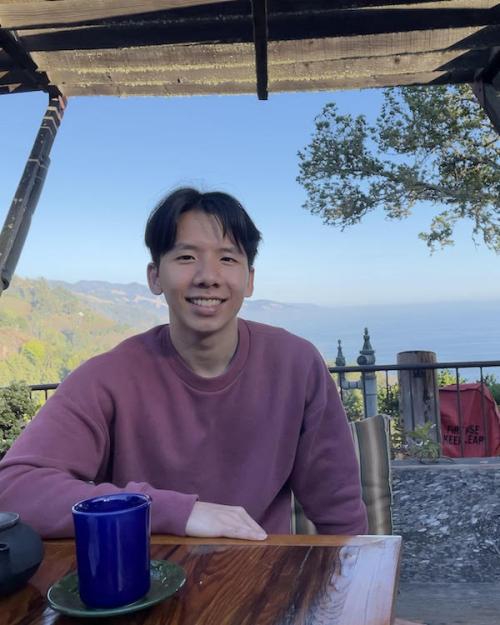Like light switches, transistors control the flow of electric currents. Transistors are the fundamental building blocks of any computing device, from smartphones to the computers in cars. According to Phuong Nguyen, a PhD candidate under the direction of Kin Fai Mak, professor of physics in the College of Arts and Sciences (A&S), and Jie Shan, professor of applied and engineering physics in Cornell Engineering and A&S, we could possibly fit billions or even trillions more transistors into a device, creating a computer that is ultrafast and consumes less energy. The key: two-dimensional materials.
Most transistors today are made of three-dimensional silicon. The size of silicon transistors has shrunk dramatically over the past several decades, but three-dimensional transistors can only get so small before running into fundamental limits in geometry and physical properties. Nguyen hopes his research at Cornell’s Laboratory of Atomic and Solid State Physics (LASSP) will lead to transistors that break free of these constraints.
The new field of two-dimensional materials aims to harness quantum particles for practical applications. The goal of creating a low-power, two-dimensional transistor has Nguyen searching for ways to achieve a viable superfluid—a fluid that flows without any resistance. A transistor made from a superfluid would need no energy to drive the current, transforming the way we power our myriad electronic needs.
Creating a Sea of Excitons
Superfluids are rare and tricky to create. To achieve his goal, Nguyen has focused on exciton condensation, a phenomenon in which a group of subatomic particles called excitons share the same quantum identity, essentially becoming a single superparticle.
“The idea is that if you generate a high enough density of excitons, by having them very close together and cooling them below a critical temperature, it will produce something called the Bose-Einstein condensate,” Nguyen says. The Bose-Einstein condensate is a coherent state of matter with macroscopic properties, making it a promising mechanism for realizing a superfluid.
To test his hypothesis, Nguyen first needs to produce excitons, a kind of quasiparticle. The recipe for an exciton sounds simple. The first ingredient is an electron—a negatively charged particle that is generally the carrier of electric current in metals and semiconductors. The second ingredient is a hole—an empty state or antiparticle of an electron, with a positive charge. With opposite charges, the electron and hole attract each other and pair together into an exciton.
The challenge is finding two-dimensional materials that can form stable, long-lasting excitons. Nguyen needs materials that bond well together, forming a strong exciton that can withstand the temperatures he applies to them.
For a year, Nguyen and his lab mates paired various materials to find a combination that would fit their needs. After many trials that yielded unstable excitons, the team found two inorganic compounds that work well together: molybdenum diselenide (MoSe2) and tungsten diselenide (WSe2). The first compound supplies the electrons, the second supplies the holes.
“At some point, it’s like they begin talking to each other, saying, ‘Let’s act as one.’”
Nguyen starts by making two-dimensional flakes of molybdenum diselenide and tungsten diselenide by hand through a process called mechanical exfoliation: He uses Scotch Tape to repeatedly peel layers from the surface of the two materials. The technique produces very thin, two-dimensional flakes that can be seen only through a microscope. He stacks the tungsten diselenide flake on top of the molybdenum diselenide flake to create conditions favorable for exciton formation.
Nguyen then applies an electronic charge between the two layers. As he increases the voltage, more and more excitons are created and the space between them narrows until he has what he calls a “sea of excitons.”
“At some point, it’s like they begin talking to each other, saying, ‘Let’s act as one.’ They start moving together at the same rate, billions of excitons acting as a single one,” Nguyen says.
Once the excitons start to strongly interact, losing their individual identity in a quantum phenomenon known as coherent superposition, Nguyen begins the condensation process.
“To make the Bose-Einstein condensate, we put the two-dimensional materials in a specialized fridge. This cools down the excitons to very low temperatures, near zero kelvin, which is absolute zero. It’s the coldest temperature that can exist,” Nguyen says. When the excitons reach a low enough energy point, they will coalesce to form one single state.
“In my previous project, we were able to generate this sea of excitons, but we need to do more experiments to fully support this claim,” Nguyen says. “We currently have an ongoing effort to take the next step and realize an exciton superfluid, to make the excitons flow without dissipation.”
The very first Bose-Einstein condensate was realized less than thirty years ago. “This is new research,” Nguyen says. “This work has only been theorized before. The Bose-Einstein condensate has been realized before, but never for excitons.” According to Nguyen, the group that he’s a part of at LASSP is among the first to attempt to make a condensate from excitons.
Physics Matters
Nguyen fell in love with solid state physics during his undergraduate years at the University of Alabama, where he worked in two labs dealing with two-dimensional material research. The research conducted at LASSP, a leading program in the field, led him to continue his work at Cornell.
Nguyen believes solid state research is the key for creating new, innovative, life-changing technologies. “Your phone is a computer; your car is a computer. Solid state research, [sometimes called] experimental condensed matter research, is everywhere, and it has a very big impact in how we operate the world. Physics has launched inventions that have changed the world, our understanding of it, and how we operate it,” he says.




